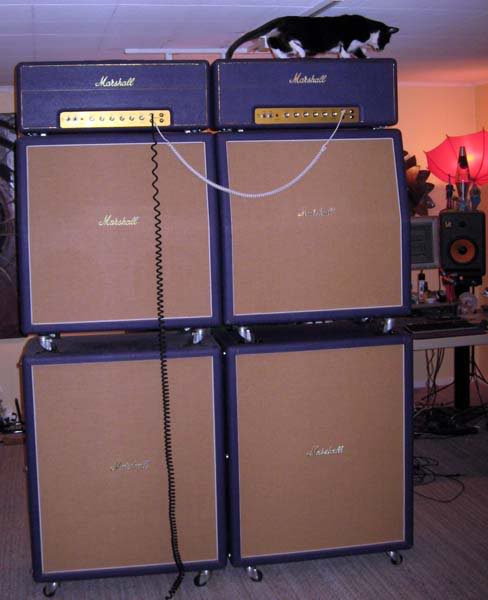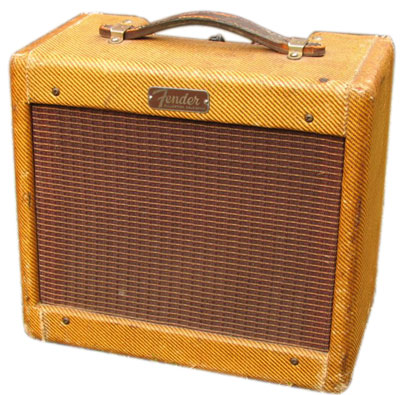This is a guest post by James Abel
Both large and small amplifiers have their benefits, whether it is portability, headroom or just plain ‘mojo’ it’s safe to say that both stand up strong in the battle of the elephant vs. the mouse. With that said, the pendulum also swings the other way, with both having their shortcomings. This article looks to host the sparring match between the two, by taking a look at both the pros and cons of each kind of amplifier.
Going large:
 Whether it’s the visual effect, or the colossal trouser flapping oomph that it exudes, I’m sure most would agree with the notion that a wall of amps is seriously cool. Similarly amplifiers like a 100-Watt Marshall atop a 4×12, or a large combo like a Fender Twin reverb, possesses a certain comforting characteristic. For example, anyone that has gigged with one of the amps mentioned above can rest assure that they are head in the mix, while maintaining the integrity of their tone. Furthermore, higher wattage amps tend to allow more headroom than their low wattage cousins, providing another argument for why big is better. However, large amps do have their drawbacks. For one, today’s gigging climate doesn’t always require a loud, unruly brute of an amplifier that’s going to rip the head off the first three rows of an audience. Ok, so the hard rock and metal heads like myself out there may not agree with this, as there is nothing quite like the feeling of your amplifier moving air. However, most sound technicians tend to prefer it when you run your amp at a lower volume, and instead use a mic to get the projection and volume that is required for live use. On top of that, some high wattage amplifiers are not always suitable for use in the home; any of you with angry neighbours are probably already aware of this problem though. In some instances portability is a definite issue. Carrying a large combo up and down the stairs of a small venue is certainly not the most enjoyable of tasks, especially when the temperature of the venue feels like a furnace. Yet, this does generally seem to be more of a problem with combos than with heads, as most venues supply their own cabinets. However, the obvious issue with that is that you’re often made to jeopardise your tone in a bid to encourage functionality. Still, regardless of all of this, many of us still persist with using big amplifiers. Whether it’s the tone we can pull from them, the sheer thrill of the appearance, or just because there are more options in the market, there is something extremely exciting about using a large amplifier. With that in mind, I don’t see their popularity dwindling any time soon.
Whether it’s the visual effect, or the colossal trouser flapping oomph that it exudes, I’m sure most would agree with the notion that a wall of amps is seriously cool. Similarly amplifiers like a 100-Watt Marshall atop a 4×12, or a large combo like a Fender Twin reverb, possesses a certain comforting characteristic. For example, anyone that has gigged with one of the amps mentioned above can rest assure that they are head in the mix, while maintaining the integrity of their tone. Furthermore, higher wattage amps tend to allow more headroom than their low wattage cousins, providing another argument for why big is better. However, large amps do have their drawbacks. For one, today’s gigging climate doesn’t always require a loud, unruly brute of an amplifier that’s going to rip the head off the first three rows of an audience. Ok, so the hard rock and metal heads like myself out there may not agree with this, as there is nothing quite like the feeling of your amplifier moving air. However, most sound technicians tend to prefer it when you run your amp at a lower volume, and instead use a mic to get the projection and volume that is required for live use. On top of that, some high wattage amplifiers are not always suitable for use in the home; any of you with angry neighbours are probably already aware of this problem though. In some instances portability is a definite issue. Carrying a large combo up and down the stairs of a small venue is certainly not the most enjoyable of tasks, especially when the temperature of the venue feels like a furnace. Yet, this does generally seem to be more of a problem with combos than with heads, as most venues supply their own cabinets. However, the obvious issue with that is that you’re often made to jeopardise your tone in a bid to encourage functionality. Still, regardless of all of this, many of us still persist with using big amplifiers. Whether it’s the tone we can pull from them, the sheer thrill of the appearance, or just because there are more options in the market, there is something extremely exciting about using a large amplifier. With that in mind, I don’t see their popularity dwindling any time soon.
Little monsters:
On the other hand, the popularity of smaller amplifiers seems to be increasing. The first obvious benefit of using a small amplifier, for example the Marshall class 5 recently reviewed on here, is portability. Carrying your amplifier to a venue becomes a much simpler and more functional task, and with the likes of Marshall, Blackstar, Vox, Fender and many more offering single speaker combos, there is enough variety to satisfy pretty much every faction of player. Another benefit of using  a small amplifier is that they really can be pushed. Whether it’s an overdrive, a boost or just the volume control used, a small valve amp at full tilt truly gives off a magical sound. Small amps are also fantastic for recording both at home, and in the studio. Tracks such as Layla, or albums such as Zeppelin I stand as a worthy testament to this. Versatility is hardly a problem here either, with companies such as Blackstar and Laney offering multi-channel low wattage amplifiers. However, much like before, there are some shortcomings of the pipsqueaks of the amplifier world. Volume can often be an issue, as although most of the low wattage amplifiers on the market can provide a hefty right hook, many actually struggle to climb over the top of a drummer. Furthermore, although the volume of the amplifiers can’t always compete in a band without a microphone, they’re often surprisingly too loud for use in the home. Thankfully, many companies are aware of this, and do provide a low wattage option on their little monsters. Another problem with using a smaller amplifier is that many sacrifice speaker quality in a bid to make the amplifier more affordable. However, if you are privy to vintage or boutique gear then this is less likely to be a problem. Besides, as mentioned earlier, most venues supply an external speaker cabinet that can always be paired with a smaller amplifier providing it has an external speaker output.
a small amplifier is that they really can be pushed. Whether it’s an overdrive, a boost or just the volume control used, a small valve amp at full tilt truly gives off a magical sound. Small amps are also fantastic for recording both at home, and in the studio. Tracks such as Layla, or albums such as Zeppelin I stand as a worthy testament to this. Versatility is hardly a problem here either, with companies such as Blackstar and Laney offering multi-channel low wattage amplifiers. However, much like before, there are some shortcomings of the pipsqueaks of the amplifier world. Volume can often be an issue, as although most of the low wattage amplifiers on the market can provide a hefty right hook, many actually struggle to climb over the top of a drummer. Furthermore, although the volume of the amplifiers can’t always compete in a band without a microphone, they’re often surprisingly too loud for use in the home. Thankfully, many companies are aware of this, and do provide a low wattage option on their little monsters. Another problem with using a smaller amplifier is that many sacrifice speaker quality in a bid to make the amplifier more affordable. However, if you are privy to vintage or boutique gear then this is less likely to be a problem. Besides, as mentioned earlier, most venues supply an external speaker cabinet that can always be paired with a smaller amplifier providing it has an external speaker output.
In Conclusion:
As is the way with everything in the world of guitars, choosing a large or small amp is simply down to a matter of opinion. It’s obvious that both have their Pros and Cons, and it truly is a matter of what ticks your boxes. Yet when push comes to shove, both are wonderful and excellent in their own rights, and should certainly be giving equal measures of respect and use.
GuitarToneTalk.com is a participant in the Amazon Services LLC Associates Program, an affiliate advertising program designed to provide a means for sites to earn advertising fees by advertising and linking to Amazon.com
Just like the two cars going up a steep hill; The mini will do it ok however the big boy will do it without any effort.
I am prepared to still use my blackface Fender twin at any venue, just turn it right down – no problem, I do not want to be restricted on live sound, just my opinion everybody to their own’
I am a Country Music (old style player ).
After the heart attack I might change my views!